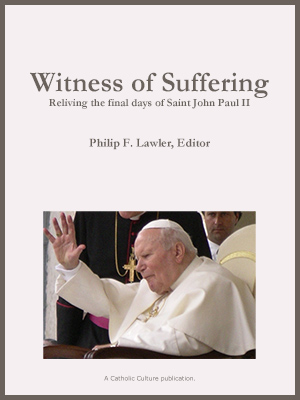Catholic Activity: The Passover Meal: 4. Introductory Blessings
A Catholic family can enter more deeply into the Passion of Christ by having a seder meal, similar to the Passover, or Last Supper that Jesus would have celebrated with his Apostles. With the knowledge that Christ has come and redeemed the world, we can incorporate a Christian attitude during the seder meal.
At the beginning of the seder meal, a traditional Jewish blessing that also explains the origin of the seder meal and its history. Included here is the blessing with Christian meditations.
DIRECTIONS
All gather around the table and stand quietly. The mother, or chosen hostess, lights a candle, since it is the Jewish mother''s privilege to light the Sabbath candles.
MOTHER OR HOSTESS: The traditional prayer of the mother in the Jewish family as she lights the feast day candle before the meal is this:
Blessed art thou, O Lord God, King of the universe, who hast sanctified us by thy commandments and hast commanded us to kindle the festival lights. Blessed art thou, O Lord God, King of the universe, who hast kept us alive and sustained us and brought us to this season. May our home be consecrated O God, by the light of thy countenance shining upon us in the blessing and bringing us peace.
FATHER OR LEADER: This is Holy Week, a time that joins for us the Old and the New Covenant. At this season the Jewish people celebrate the feast of the Passover or Pasch. More than 1,400 years before the time of Christ, the chosen people were suffering in slavery in Egypt. God raised up Moses as their leader and Moses tried to secure their release from captivity. Despite the hardships of nine successive plagues which God sent to them, the Egyptians still refused the pleas of Moses. Then an angel of the Lord was sent to strike down the first born son of every family; but at God's command, each Jewish family had sacrificed a lamb and sprinkled its blood on the doorposts. And the angel, seeing the blood, passed over their homes and their children were spared.
Then, finally, Pharaoh permitted the Jews to leave. They fled in haste, to wander amid the hardships in the desert for forty years before coming to the promised land. And God commanded Moses that the Jews should make a remembrance of their day of deliverance (Exodus 12:14-28). Thus the Passover became the great feast of sacrifice, of deliverance and of thanksgiving. Each Passover meal revolves around the retelling (the Haggadah) of this Providential act.
We who are the followers of Christ see the working of God''s concern for His people. As God sent Moses to rescue the Israelites from captivity in Egypt, so He lovingly sent His Son to redeem fallen man from slavery to sin. By the sacrifice of Himself, Christ opened the gates of heaven to us.
At this time Christians and Jews celebrate their own feasts in their own ways and we can see in these celebrations the common bond of the symbolism of the Exodus. Jesus was a Jew and today we wish to draw upon the traditional Jewish Seder and the words of the New Testament to help us more fully appreciate Jesus'' observance of His Jewish heritage, whose laws He kept.
Matthew's, Mark's and Luke's accounts of Christ's sacrifice for us each begin with His celebration of the paschal meal:
Now on the first day of Unleavened Bread the disciples came to Jesus to say, ''Where do you want us to make the preparations for you to eat the Passover?" (Matt. 26:17) (see also Mark 14:12 and Luke 22:7-9)
Activity Source: Passover Meal, The by Arleen Hynes, Paulist Press, 1972







